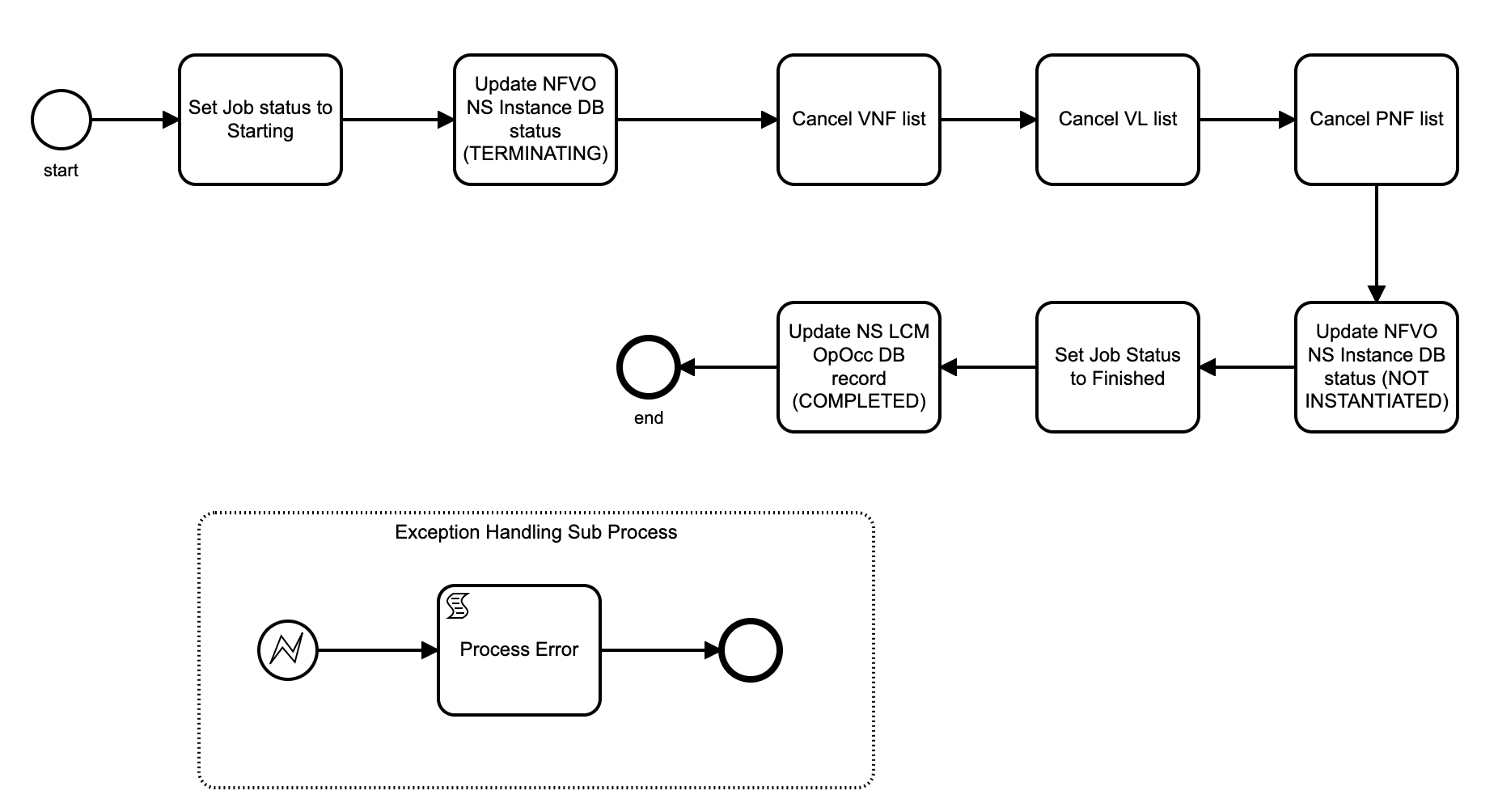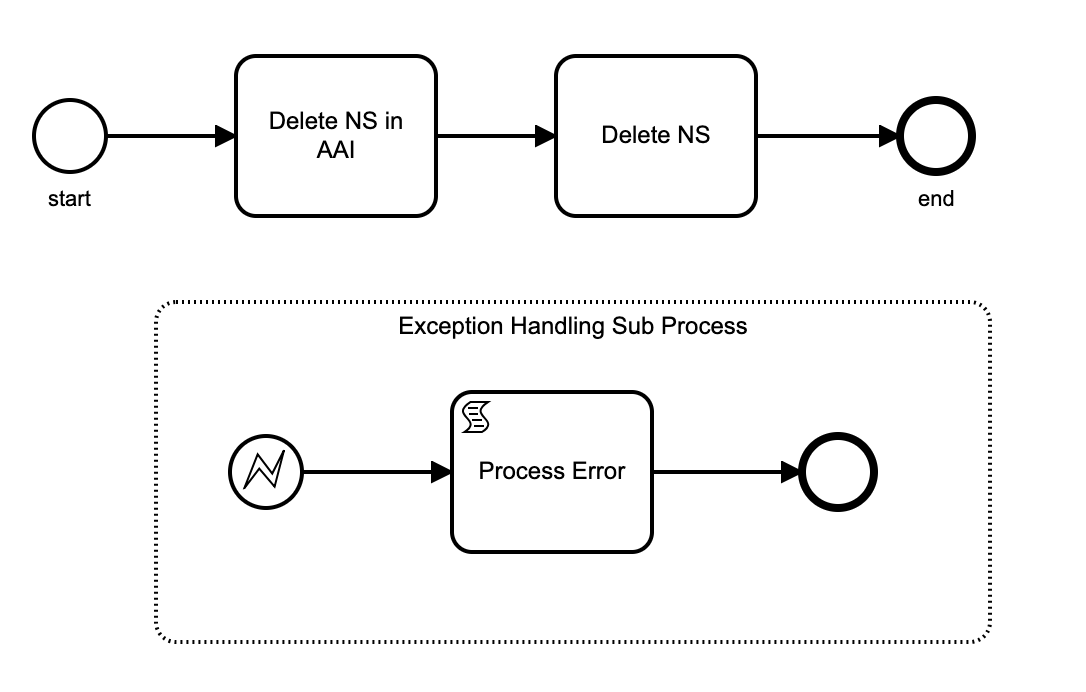This proposal conforms to the following ETSI v2.7.1 specifications.
![]()
ONAP SO NFVO provides ETSI NFV-compliant NFVO functions.

Epic | User Story | Description | In Guilin Plan? | JIRA | Size |
|---|---|---|---|---|---|
Support for ETSI NFV NFVO Orchestrator in ONAP SO (ONAP SO ETSI-Aligned Hierarchical Orchestration) | Executive Summary - Enable E2E workflows by orchestrating ETSI NFV compliant Network Services and VNFs. This NFVO should provide an ETSI NFV SOL005 v2.7.1 NBI which can onboard ETSI NFV SOL004 and ETSI NFV SOL007 v2.7.1 compliant packages which then can be Life Cycle Managed and monitored. This NFVO should use an ETSI SOL003 v2.7.1 SBI to invoke an external VNF Manager. Business Impact - Enables operators and service providers to use Industry standard Orchestration to deploy, manage and monitor network services. Industry compatibility. Business Markets - All operators and service providers that are developing ETSI compatible Network Services especially for 5G Slicing where each Slice Subnet is associated with a Network Service Funding/Financial Impacts - Reduction in operations expense from using industry standard ETSI Orchestration. Organization Mgmt, Sales Strategies -There is no additional organizational management or sales strategies for this requirement outside of a service providers "normal" ONAP deployment and its attendant organizational resources from a service provider. | Yes | |||
The following diagram depicts the NFVO component architecture
![]()
Support NS Performance Management APIs (stretch goal)
Allows hot deployment of custom workflow packages while ONAP NFVO is running


TBD
Collects Homing information from OOF and provides the information to other NFVO components
Container Image Management (stretch goal)
Virtualized Resources Capacity Management
Virtualized Resources Change Management
Virtualized Resource Quota Management
Virtualized Resource Fault Management
TBD
| Descriptions | |
|---|---|
| Existing SO E2E Business Logic for VFC/SOL005 Adapter |
|
| New ONAP SO NFVO Path |
|
Note: to analyze the following further (extracting NS-related operations)
| ONAP SO | NFVO |
|---|---|
Asdc-controller (scope: Service, NS, VNF, VF-Module) | Asdc-controller for NS, leveraging ETSI Catalog Manager |
API Handler | SOL005 API Handler |
BPMN Infra (scope: Service, NS, VNF, VF-Module) including Workflows with embedded Camunda Workflow engine | NS LCM + Default NS Workflows (with business logic) + Custom NS Workflows (with business logic) Stand-Alone/Clustered Camunda Workflow Engine |
VFC / SOL005 Adapter | Not Applicable |
SOL003 Adapter in SO | SOL003 Adapter in NFVO (move its home) |
Catalog DB Adapter | Leverage ETSI Catalog Manager |
Request DB Adapter (scope: service, NS, VNF, VF-Module) | Request DB Adapter for NS scope |
APPC Orchestrator | Configuration Manager Client |
ve-vnfm-adapter (SOL002 Adapter) | TBD |
sdnc-adapter | TBD |
nssmf-adapter | TBD |
Openstack adapter / MultiCloud adapter | Resource Manager |
VNF Adapter | Not Applicable (SOL003 Adapter delegates VNF operations to SVNFM) |
K8S Client (PoC) | K8S Client |
SO-monitoring | SO-monitoring for NS and VNF |
Common (beans and utils common for all the projects) | Leverage Common as needed |
Close Loop Handling | FM/PM Event Handler |
![]()
The following diagram depicts the Create/Instantiate NS.
@startuml
participant SO
participant SOL005_Adapter
participant SOL005_NBI
participant NS_LCMGR
participant Resource_Mgr
participant OOF
participant Catalog_DB_Adapter
participant ETSI_Catalog_Mgr
participant Inventory_DB_Adapter
participant AAI
participant SOL003_Adapter
participant VIM
participant VNFM
autonumber
group Create NS
SO -> SOL005_Adapter : Create NS
SOL005_Adapter -> SOL005_NBI : Create NS
SOL005_NBI -> NS_LCMGR : Create NS
NS_LCMGR -> Resource_Mgr : Create NS record
Resource_Mgr -> Inventory_DB_Adapter : Create NS record
Inventory_DB_Adapter -> AAI : Create NS record
AAI --> AAI : Create NS record
AAI -> Inventory_DB_Adapter : Response for Create NS record
Inventory_DB_Adapter -> Resource_Mgr: Response for Create NS record
Resource_Mgr -> NS_LCMGR : Response for Create NS record
NS_LCMGR -> SOL005_NBI : Response for Create NS record
SOL005_NBI -> SOL005_Adapter : Response with NS Instance Id
SOL005_Adapter -> SO : Response with NsInstance\n(including NS Instance Id)
NS_LCMGR -> SOL005_NBI : Send\nNsIdentifierCreationNotification
SOL005_NBI -> SOL005_Adapter : Send\nNsIdentifierCreationNotification
SOL005_Adapter -> SO : Send\nNsIdentifierCreationNotification
end
group Instantiate NS
NS_LCMGR -> Catalog_DB_Adapter : Read NS descriptor
Catalog_DB_Adapter -> ETSI_Catalog_Mgr : Read NS descriptor
ETSI_Catalog_Mgr -> Catalog_DB_Adapter : Return NS descriptor
Catalog_DB_Adapter -> NS_LCMGR : Return NS descriptor
NS_LCMGR --> NS_LCMGR : Parse & Decompose NS descriptor
NS_LCMGR --> NS_LCMGR : Instantiate NS
NS_LCMGR --> NS_LCMGR : Instantiate VLs between VNFs
NS_LCMGR -> Resource_Mgr : Create Network
Resource_Mgr -> VIM : Create Network
VIM -> Resource_Mgr : Response for Create Network
Resource_Mgr -> NS_LCMGR : Response for Create Network
NS_LCMGR -> Resource_Mgr : Create VL record
Resource_Mgr -> Inventory_DB_Adapter : Create VL record
Inventory_DB_Adapter -> AAI : Create VL record
AAI --> AAI : Create VL record
AAI -> Inventory_DB_Adapter : Response for Create VL record
Inventory_DB_Adapter -> Resource_Mgr : Response for Create VL record
Resource_Mgr -> NS_LCMGR : Response for Create VL record
NS_LCMGR -> Resource_Mgr : Request Homing Information\nfor Network Service
Resource_Mgr -> OOF : Requests Homing Information\nfor Network Service
OOF -> Resource_Mgr : Response with Homing Information\nfor Network Service
Resource_Mgr --> Resource_Mgr : Persist Homing Information\nfor Network Service
loop Go through each VNF
NS_LCMGR -> SOL003_Adapter : Request for Instantiate VNF
SOL003_Adapter -> VNFM : Request for Instantiate VNF
VNFM -> SOL003_Adapter : Request Grant VNF resource
SOL003_Adapter -> NS_LCMGR : Request Grant VNF resource
NS_LCMGR -> Resource_Mgr : Request Homing Information
Resource_Mgr -> NS_LCMGR : Return with Homing Information\nfor the VNF
NS_LCMGR --> NS_LCMGR : Make a Grant decision
NS_LCMGR -> SOL003_Adapter : Return with a Grant decision
SOL003_Adapter -> VNFM: Return with a Grant decision
VNFM --> VNFM : Instantiate VNF
VNFM -> SOL003_Adapter : Notify the changes\nof VNF/VDUs/CPs
SOL003_Adapter -> NS_LCMGR : Notify the changes\nof VNF/VUD/CPs
end
NS_LCMGR -> SOL005_NBI : Send\nnsLcmOperationOccurrenceNotification
SOL005_NBI -> SOL005_Adapter : Send\nnsLcmOperationOccurrenceNotification
SOL005_Adapter -> SO : Send\nnsLcmOperationOccurrenceNotification
end
@enduml |

CreateNsRequest
NsInstance
VFC design
get nsdId, nsName and nsDescription, context (globalCustomerId, serivceType) parameters
Proposal
The following diagram depicts the Create NS procedure.


InstantiateRequest
201 Accepted
NsLcmOperationOccurrenceNotification (Start/Processing/Completed)
VFC Design
Proposal
The following diagram depicts the Instantiate NS.

The following diagram depicts the Terminate / Delete NS.
@startuml
participant SO
participant SOL005_Adapter
participant SOL005_NBI
participant NS_LCMGR
participant Resource_Mgr
participant OOF
participant Catalog_DB_Adapter
participant ETSI_Catalog_Mgr
participant Inventory_DB_Adapter
participant AAI
participant SOL003_Adapter
participant VIM
participant VNFM
autonumber
group Terminate NS
SO -> SOL005_Adapter : Terminate NS
SOL005_Adapter -> SOL005_NBI : Terminate NS
SOL005_NBI -> NS_LCMGR : Terminate NS
NS_LCMGR -> Resource_Mgr : Query all instances related to NS
Resource_Mgr -> Inventory_DB_Adapter : Query all instances related to NS
Inventory_DB_Adapter -> AAI : Query all instances related to NS
AAI -> Inventory_DB_Adapter : Return all instances for NS
Inventory_DB_Adapter -> Resource_Mgr : Return all instances for NS
Resource_Mgr -> NS_LCMGR : Return all instances for NS
NS_LCMGR --> NS_LCMGR : Start Delete NS instances
NS_LCMGR -> Resource_Mgr : Request Homing Information\nfor Network Service
Resource_Mgr -> OOF : Requests Homing Information\nfor Network Service
OOF -> Resource_Mgr : Response with Homing Information\nfor Network Service
Resource_Mgr --> Resource_Mgr : Persist Homing Information\nfor Network Service
loop Go thru each VNF
NS_LCMGR -> SOL003_Adapter : Delete VNF
SOL003_Adapter -> VNFM : Delete VNF
VNFM -> SOL003_Adapter : Request Grant resource for deletion
SOL003_Adapter -> NS_LCMGR : Request Grant resource for deletion
VNFM -> SOL003_Adapter : Request Grant VNF resource
SOL003_Adapter -> NS_LCMGR : Request Grant VNF resource
NS_LCMGR -> Resource_Mgr : Request Homing Information
Resource_Mgr -> NS_LCMGR : Return with Homing Information\nfor the VNF
NS_LCMGR --> NS_LCMGR : Make a Grant decision
NS_LCMGR -> SOL003_Adapter : Return with a Grant decision
SOL003_Adapter -> VNFM: Return with a Grant decision
VNFM --> VNFM : Delete Resources
VNFM -> SOL003_Adapter : Notify changes of VNF/VDUs/CPs
SOL003_Adapter -> NS_LCMGR : Notify changes of VNF/VDUs/CPs
NS_LCMGR -> Resource_Mgr : Update records for Delete VNF/VDUs/CPs
Resource_Mgr -> Inventory_DB_Adapter : Update records for Delete VNF/VDUs/CPs
Inventory_DB_Adapter -> AAI : Update records for Delete VNF/VDUs/CPs
AAI --> AAI : Update records for Delete VNF/VDUs/CPs
AAI -> Inventory_DB_Adapter : Return with Delete VNF/VDUs/CPs
Inventory_DB_Adapter -> Resource_Mgr : Return with Delete VNF/VDUs/CPs
Resource_Mgr -> NS_LCMGR : Return with Delete VNF/VDUs/CPs
end
NS_LCMGR -> Resource_Mgr : Request for Delete VLs (if needed)
Resource_Mgr -> VIM : Request for Delete VLs
VIM --> VIM : Delete VLs
NS_LCMGR -> Resource_Mgr : Update records for Delete VLs
Resource_Mgr -> Inventory_DB_Adapter : Update records for Delete VLs
Inventory_DB_Adapter -> AAI : Update records for Delete VLs
AAI --> AAI : Update records for Delete VLs
AAI -> Inventory_DB_Adapter : Return with Delete VLs
Inventory_DB_Adapter -> Resource_Mgr : Return with Delete VLs
Resource_Mgr -> NS_LCMGR : Return with Delete VLs
NS_LCMGR -> SOL005_NBI : Send\nnsLcmOperationOccurrenceNotification
SOL005_NBI -> SOL005_Adapter : Send\nnsLcmOperationOccurrenceNotification
SOL005_Adapter -> SO : Send\nnsLcmOperationOccurrenceNotification
end
@enduml |

TerminateNsRequest
201 Accepted
NsLcmOperationOccurrenceNotification (Start/Processing/Completed)
VFC Design
Proposal
The following diagram depicts the Terminate NS.


VFC_Design
Proposal
The following diagram depicts the Delete NS.

@startuml
participant SO
participant SOL005_Adapter
participant SOL005_NBI
participant NS_LCMGR
autonumber
group Create Subscription NS
SO -> SOL005_Adapter : Create Subscription NS
SOL005_Adapter -> SOL005_NBI : Create Subscription NS
SOL005_NBI -> NS_LCMGR : Create Subscription NS
NS_LCMGR --> NS_LCMGR : Check Subscription Filter
NS_LCMGR -> NS_LCMGR : Test subscription\nnotification (callbackUrl) endpoint
NS_LCMGR --> NS_LCMGR : Save Subscription to Database
NS_LCMGR -> SOL005_NBI : Response with LccnSubscription
end
group Delete Subscription NS
SO -> SOL005_Adapter : Delete Subscription NS
SOL005_Adapter -> SOL005_NBI : Delete Subscription NS
SOL005_NBI -> NS_LCMGR : Delete Subscription NS
NS_LCMGR --> NS_LCMGR : Delete Subscription NS
NS_LCMGR -> SOL005_NBI : Response with 204 No Content
SOL005_NBI -> SOL005_Adapter : Response for Delete Subscription NS
SOL005_Adapter -> SO : Response for Delete Subscription NS
end
@enduml |

The following table describes the Subscription filter request.
| attribute name | data type | cardinality | description |
|---|---|---|---|
nsdIds | Identifier | 0..N | If present, match NS instances that were created based on an NSD identified by one of the nsdId values listed in this attribute. See note 1. |
vnfdIds | Identifier | 0..N | If present, match NS instances that contain VNF instances that were created based on a VNFD identified by one of the vnfdId values listed in this attribute. See note 1. |
| pnfdIds | Identifier | 0..N | If present, match NS instances that contain PNFs that are represented by a PNFD identified by one of the pnfdId values listed in this attribute. See note 1. |
| nsInstanceId | Identifier | 0..N | If present, match NS instances with an instance identifier listed in this attribute. See note 2. |
| nsInstanceNames | String | 0..N | If present, match NS instances with an NS Instance Name listed in this attribute. See note 2. |
NOTE 1: The attributes "nsdIds", "vnfdIds" and "pnfdIds" are alternatives to reference to NS instances that are created based on certain NSDs, or contain VNF instances that are based on certain VNFDs, or contain PNFs that are based on certain PNFDs in a filter. They should not be used together in the same filter instance, but one alternative should be chosen. NOTE 2: The attributes "nsInstanceIds" and "nsInstanceNames" are alternatives to reference to particular NS Instances in a filter. They should not be used both in the same filter instance, but one alternative should be chosen. | |||
VFC Design
Proposal
The following diagram depicts the Subscription NS.
